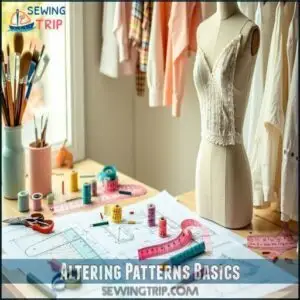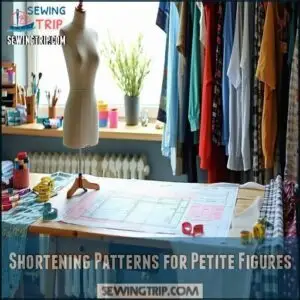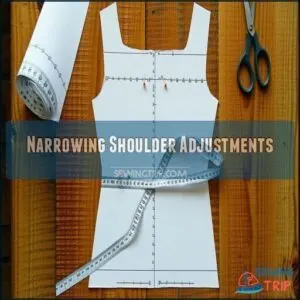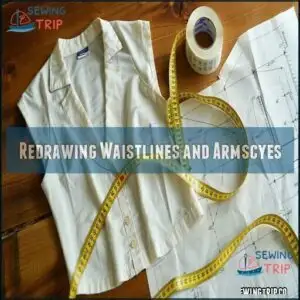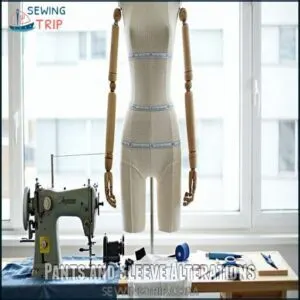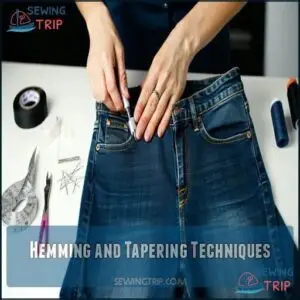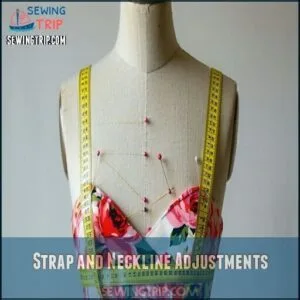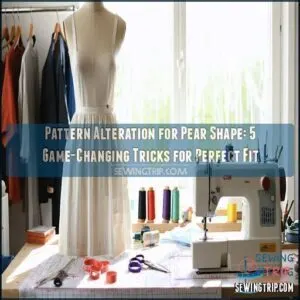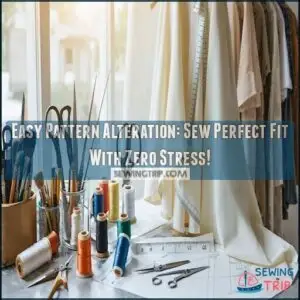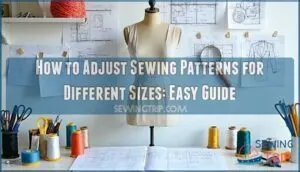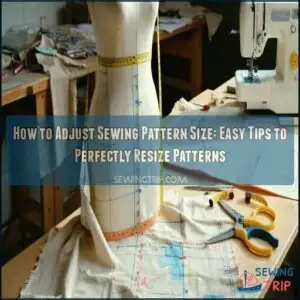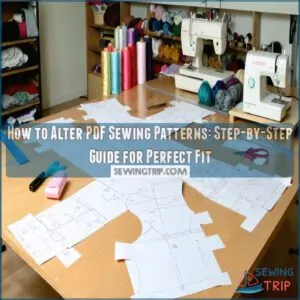This site is supported by our readers. We may earn a commission, at no cost to you, if you purchase through links.
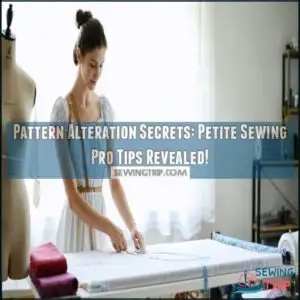
You’ll want to start by taking precise measurements, focusing on your unique proportions.
Shorten pattern lengths strategically, typically reducing 1-2 inches from the bodice and skirt.
Pay special attention to shoulder width and armhole depth, as these can make or break your fit.
Narrow shoulders? Adjust pattern shoulders inward by 1/2 inch.
Waistline too low? Raise it to create a more proportional silhouette.
With practice, you’ll transform standard patterns into custom-fit garments that look like they were made just for you.
Table Of Contents
Key Takeaways
- You’ll transform your sewing game by taking precise measurements and understanding your unique petite body proportions, which are the foundation of perfect pattern alterations.
- Master strategic length modifications by shortening bodice and skirt patterns, adjusting shoulder width, and reshaping armholes to create garments that flatter your petite frame.
- Don’t skip the muslin fitting stage—it’s your roadmap to success, allowing you to pinch, fold, and mark fabric to reveal critical adjustments that’ll make your patterns fit like they were custom-made.
- You’ll need key tools like sharp fabric scissors, a flexible measuring tape, and marking chalk to make precise pattern alterations that turn standard sizes into personalized, perfectly fitting garments.
Altering Patterns Basics
If you’re a petite sewist tired of ill-fitting patterns, you’re in the right place to learn game-changing alteration techniques.
Understanding your unique body proportions and mastering precise pattern adjustments will transform your sewing projects from frustrating to fabulous, giving you the confidence to create perfectly fitted garments that fit like a dream.
Understanding Petite Proportions
Because petite figures are more than just height, understanding your unique proportions is key to nailing the perfect fit.
Master your body’s unique blueprint to transform off-the-rack patterns into custom-feeling creations.
Petite pattern alteration is an art form that goes beyond simple hemming.
Consider these critical aspects:
- Shorter torso length
- Proportionally smaller frame
- Unique body shape variations
- Specific measurement challenges
Master your petite body’s unique blueprint to transform off-the-rack patterns into custom-feeling creations.
Importance of Accurate Measurements
Before diving into pattern alterations, you’ll need laser-sharp measurement precision. Grab your flexible measuring tape and mark body landmarks carefully.
Consistency is key—always measure in the same posture and undergarments. Digital measurement records help track changes over time.
Accurate sewing requires a quality measuring tool. Calibrate your tools and techniques to guarantee fit accuracy that transforms your sewing from good to phenomenal.
Common Alteration Challenges
You’ve probably wrestled with patterns that never quite fit right.
Petite sewists face unique challenges like pants bunching at ankles, sleeves drowning your arms, and necklines gaping awkwardly.
These silhouette shaping struggles demand strategic adjustments—from torso length tweaks to precise sleeve shortening.
Mastering petite body measurements means transforming ill-fitting garments into perfectly customized pieces.
A key step is to understand pattern alteration basics for a better fit, which involves strategic adjustments and precise techniques to achieve the perfect look.
Pattern Adjustment Techniques
If you’re a petite sewist tired of ill-fitting patterns, you’re in the right place to learn game-changing adjustment techniques.
These pro tips will help you transform standard patterns into perfectly fitted garments that flatter your unique body proportions, using pro tips.
Shortening Patterns for Petite Figures
Now that you understand petite proportions, it’s time to master length distribution on your sewing patterns.
You’ll want to strategically shorten your pattern pieces, spreading adjustments across torso and leg sections.
Inseam grading helps avoid bunching, while careful rise alterations guarantee a perfect fit.
Master inseam grading and rise alterations to transform baggy pants into perfectly fitted petite perfection.
Wearing ease is critical for comfort and movement.
Hem variations can transform how your petite clothing patterns drape and move, allowing for customized adjustments.
Narrowing Shoulder Adjustments
If your shoulder seams scream "too wide," it’s time to master petite shoulder modifications.
Narrow your pattern by pivoting at the shoulder point, creating a custom fit that hugs your frame.
Muslin fitting is key—slice, overlap, and true those shoulder lines to eliminate armhole gaping and achieve that perfectly customized silhouette every petite sewist dreams of.
Many online resources offer a narrow shoulder pattern for purchase, which can help you achieve a perfect fit.
Redrawing Waistlines and Armscyes
A pattern’s waistline can be a tricky beast, but with the right techniques, you’ll master petite fit adjustments like a pro.
Redraw your armscye seams and waistline by pinching out excess fabric on a muslin, then transfer those precise measurements to your pattern.
This torso proportion trick guarantees your bodice length flatters your petite frame perfectly.
Fitting Challenges and Solutions
If you’re petite and struggling with ill-fitting patterns, you’re not alone in the quest for the perfect garment.
These clever alteration techniques will help you transform standard patterns into custom-fitted pieces that showcase your unique body shape, making every sewing project a confidence-boosting success.
Pants and Sleeve Alterations
The precision of petite sewing lies in strategic pants and sleeve alterations that transform ill-fitting garments into personalized masterpieces.
Here’s your roadmap to perfect fit:
- Measure inseam length with laser accuracy
- Reshape sleeve caps for shoulder symmetry
- Adjust crotch curves to eliminate bunching
- Reduce sleeve width for proportional elegance
- Align armholes to prevent fabric rebellion
Customize your wardrobe, one stitch at a time, with a focus on personalized masterpieces.
Hemming and Tapering Techniques
From sleeve troubles to pant predicaments, hemming and tapering are your secret weapons.
Tackle those extra-long jean legs with confidence! Blind hemming techniques can transform baggy trousers into perfectly fitted masterpieces.
Consider using specialized petite alteration tools for best results.
Petite alterations aren’t just about shortening—they’re about sculpting fabric to hug your frame like a custom-made dream. Your wardrobe will thank you, and with these techniques, you can achieve a perfectly fitted look.
Strap and Neckline Adjustments
We’ve all battled those droopy straps that make our necklines sag like a tired clothesline.
Tackle neckline gaping by shortening straps and adjusting shoulder slope—key petite fit adjustments that transform how clothes hang.
When straps are too long, simply fold and stitch to create a custom fit that flatters your petite frame, making every garment look handmade just for you, with petite fit adjustments.
Advanced Alteration Methods
You’re about to discover the secret techniques that’ll transform your pattern-altering skills from amateur to pro.
These advanced methods will help you create perfectly fitted garments that look like they were custom-made just for your petite frame.
Muslin Fitting and Proportional Adjustments
Your muslin is your roadmap to sewing success.
By creating a test garment with careful attention to grainline adjustments, you’ll master iterative fitting techniques that reveal your body’s unique proportions.
Pinch, fold, and mark complex shapes directly on the muslin fabric, transforming length and width modifications into a personalized petite fit strategy.
Redrawing Patterns for Better Fit
Often, pattern blueprinting transforms your sewing game by letting you redraw key pattern lines with surgical precision.
Curved line adjustments become your secret weapon, helping you blend sizes seamlessly and draft custom darts that hug your unique petite frame.
Digital pattern manipulation lets you reshape those standard templates into perfectly crafted masterpieces, using surgical precision to create a customized fit.
Advanced Sleeve and Pant Alterations
You’ve conquered pattern basics, and now it’s time to master sleeve reshaping and petite pant alterations like a pro.
From inseam adjustments to advanced crotch modifications, these techniques transform ill-fitting garments into custom creations.
Learn to pivot, taper, and reshape with precision.
For a quick fix, consider no-sew hemming options.
Your petite frame deserves perfectly altered patterns that celebrate your unique proportions and style.
Mastering Petite Pattern Alteration
If you’re a petite sewist tired of ill-fitting patterns, you’re in the right place to transform your sewing game.
By mastering targeted pattern alterations, you’ll learn how to reshape standard patterns to fit your unique body proportions perfectly, creating garments that look like they were made just for you.
Combining Alteration Techniques
With precision and creativity, master hybrid alterations by blending multiple pattern adjustment techniques suited to your unique petite frame.
Integrated solutions like layered length modifications and targeted shoulder narrowing transform standard sewing patterns.
By strategically combining complex fittings, you’ll craft garments that celebrate your body’s proportions, turning pattern challenges into personalized wardrobe triumphs.
Troubleshooting Common Fitting Issues
After mastering combined alteration techniques, you’ll want to tackle those pesky fabric bunching and neckline gaping gremlins.
Petite size alterations demand surgical precision—reshaping sleeves, correcting armscye issues, and modifying waistline height.
Each pattern adjustment reveals a new challenge: narrowing shoulders here, lifting a drooping hemline there.
Understanding pattern ease guarantees comfort.
Your secret weapon? Patience and a keen eye for detail that transforms ill-fitting garments into custom perfection.
Creating Customized Patterns for Petite Figures
Once you’ve tackled troubleshooting, you’re ready to craft patterns as unique as your body.
Proportional scaling lets you transform standard designs into personalized masterpieces.
Learn digital patterning techniques, play with style customization, and embrace fabric choices that highlight your petite frame.
Pattern drafting for petites isn’t just alterations—it’s creating wearable art that fits like a glove, which is a form of wearable art.
Frequently Asked Questions (FAQs)
How do you alter a pattern?
Hit the ground running with pattern alterations by measuring carefully, creating a muslin mock-up, and making precise adjustments to length, width, and fit before cutting your final fabric.
What happens if a pattern is altered before the fabric is cut?
When you alter a pattern before cutting fabric, you’re setting yourself up for a perfect fit.
You’ll trace the original, make precise adjustments, and create a customized template that’ll transform your sewing project.
Do I need a pattern adjustment before cutting a garment?
You’ll want to check your muslin fit first.
Some patterns need adjustments before cutting to guarantee a flattering silhouette.
Test, tweak, and trust your measurements to avoid wasting fabric on an ill-fitting garment.
How do you adjust a dress pattern if you’re short?
You’ll need to shorten the pattern in key areas: raise the waistline, adjust shoulder width, and modify sleeve and bodice lengths.
Make a muslin test garment to guarantee a perfect, personalized fit before cutting your final fabric.
How do I adjust the width of a pattern?
Like tailoring a tent to fit a camper perfectly, you’ll trace your pattern and mark key measurement points.
Then, strategically pinch or spread the pattern pieces, adding or removing width precisely where needed for a custom-fit garment.
How do I choose the right pattern size?
Measure your bust, waist, and hip according to the pattern’s size chart.
Compare these measurements to find the best fit, then consider making minor adjustments like shortening or narrowing the pattern for a perfect custom fit.
Can I alter patterns without sewing skills?
You’ll find basic pattern alterations possible with patience and simple tools.
Start with tracing paper, scissors, and online tutorials.
Even beginners can learn to adjust lengths and seams without advanced sewing expertise.
What tools do I need for alterations?
Sarah’s tight dress transformation sparked her sewing toolkit quest.
You’ll want sharp fabric scissors, a measuring tape, pins, marking chalk, a seam ripper, pattern weights, and an iron to tackle precise garment modifications confidently, with tools like a seam ripper.
How expensive are professional pattern alterations?
Professional pattern alterations typically cost between $50-$300, depending on the complexity of the garment, tailor expertise, and your location.
Prices vary, so you’ll want to get quotes from multiple tailors for the best deal, considering the complexity of the garment.
Where can I find petite-specific sewing resources?
You’ll love Burda Style’s petite patterns and Madalynne’s online tutorials.
YouTube channels, sewing blogs, and Instagram communities like @PetiteSewingResources offer free tips, patterns, and supportive connections for mastering petite sewing techniques.
Conclusion
Mastering pattern alteration for petite figures isn’t rocket science—it’s about knowing your body’s unique blueprint.
You’ll transform standard patterns into personalized masterpieces with practice and precision. Don’t be intimidated; each adjustment brings you closer to that perfect fit.
Whether it’s shortening bodices or narrowing shoulders, you’re now equipped with pro techniques.
Remember, great style isn’t about size—it’s about understanding how to make every pattern work for your body, and great style is ultimately about personalized masterpieces.

